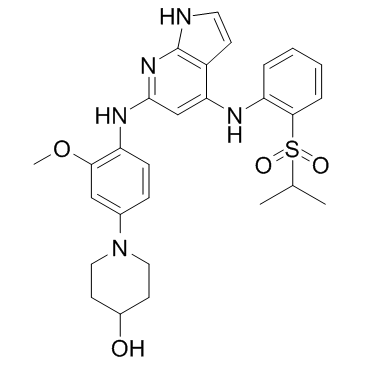1125593-20-5
| Name | 1-[3-methoxy-4-[[4-(2-propan-2-ylsulfonylanilino)-1H-pyrrolo[2,3-b]pyridin-6-yl]amino]phenyl]piperidin-4-ol |
|---|---|
| Synonyms |
Mps1-IN-1
3gfw QC-8177 cc-569 |
| Description | Mps1-IN-1 is a potent, selective and ATP-competitive Mps1 kinase inhibitor, with an IC50 and a Kd of 367 nM and 27 nM. |
|---|---|
| Related Catalog | |
| Target |
Mps1:27 nM (Kd) ALK:21 nM (Kd) LTK:29 nM (Kd) PYK2:280 nM (Kd) FAK:440 nM (Kd) IGF1R:750 nM (Kd) INSR:470 nM (Kd) CLK1:1900 nM (Kd) ERK2:2900 nM (Kd) INSRR:1200 nM (Kd) TNK1:2600 nM (Kd) TNK2:3100 nM (Kd) GAK:1100 nM (Kd) |
| In Vitro | Mps1-IN-1 is a potent, selective and ATP-competitive Mps1 kinase inhibitor, with an IC50 and a Kd of 367 nM and 27 nM. Mps1-IN-1 also has high affinity for ALK, and LTK, with Kds of 21 and 39 nM, respectively, but shows little or no inhibition on other 352 member kinases. Mps1-IN-1 (5, 10 μM) induces bypass of a checkpoint-mediated mitotic arrest in U2OS cells. Mps1-IN-1 disrupts recruitment of Mad2 to kinetochores, and reduces the phosphorylation status of Aurora B at threonine-232 (Thr232). Mps1-IN-1 (10 µM) shows no effect on centrosome duplication. In addition, Mps1-IN-1 (5-10 µM) suppresses the proliferative capacity of HCT116[1]. |
| Kinase Assay | The kinase binding assay is used to assess compound binding to TTK by monitoring displacement of a fluorescently labeled, ATP site-directed kinase inhibitor (Kinase Tracer 236) from the kinase active site. Each 15 μL assay contains 5 nM TTK, variable amounts of test compound (Mps1-IN-1), 30 nM Kinase Tracer 236, 2 nM Eu-anti-GST Antibody, and 1% DMSO (residual from compound dilution) in Kinase Buffer A (50 mM HEPES pH 7.5, 10 mM MgCl2, 1 mM EGTA, 0.01% Brij-35). Binding assays are initiated by addition of 5 μL of test compound (from 2-fold dilution series) to 5 μL of a kinase/antibody mixture, followed by addition of 5 μL of antibody. Assay plates are read using using standard Eu-based TR-FRET settings with excitation at 340 nm and emission monitored at 615 nm (donor) and 665 nm (acceptor). Emission intensities are measured over a 200 µs window following a 100 µs post-excitation delay[1]. |
| Cell Assay | U2OS cells expressing doxycycline-inducible PLK4 are plated in 96 well plates. A double thymidine block is performed using the following treatment regimen: thymidine for 18-20 hrs., release for 10 hrs. with doxycycline induction of PLK4 during this time, then a second thymidine block, followed by release. Six hours after the 2nd thymidine release, Mps1-IN-1 (or DMSO vehicle) is added and the proliferation of the cell populations is monitored with Cell Titer GLO assay[1]. |
| References |
| Molecular Formula | C28H33N5O4S |
|---|---|
| Molecular Weight | 535.65800 |
| Exact Mass | 535.22500 |
| PSA | 131.19000 |
| LogP | 5.84260 |
| Storage condition | 2-8℃ |
